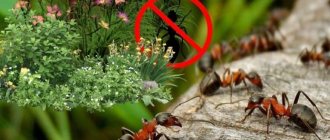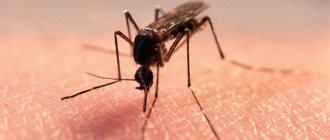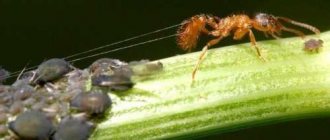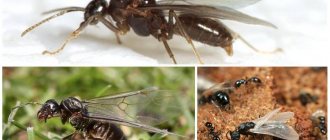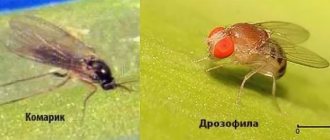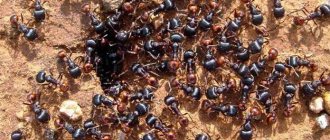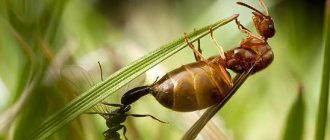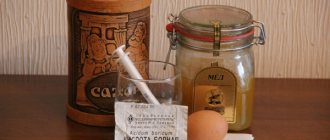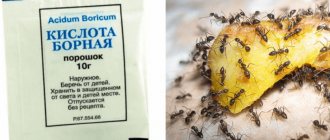In the Central region of Russia, problems in a garden, apartment or room are usually caused by black, red, red-breasted or house ants. Each of these species has its own favorite habitats.
- Red and red-breasted ants can make anthills directly in the structure of a house or other building, inside furniture.
- House ants and black ants prefer to live outside and enter indoors only in search of food or during migration, when the colony moves in an organized formation in one specific direction.
All these types of ants have a similar anatomical structure and sensory organs, so you can fight them using the same methods. What are ants afraid of? What means can be used to combat them?
What plants repel aphids and ants. Protective plants
This category includes not only those companion plants that repel insects, but also those that, figuratively speaking, confuse and confuse them.
Many insects find plants suitable for feeding by smell. For example, flea beetles and cabbage cutworms find cabbage by smell. If you plant strong-smelling plants near the cabbage, such as thyme or sage, or sprinkle it with an extract of these herbs, they will muffle the smell of the cabbage and make it less attractive to pests. Aromatic herbs confuse pests with their strong smell and protect garden crops. Therefore, it is recommended to plant basil near beans to protect against bean weevils, garlic near roses to protect against aphids, and parsley near asparagus. True, the effect of herbs is not always manifested to the same extent. Plants that repel insects by smell can be classified as repellent plants. These include nasturtium, which repels whiteflies, aphids, Colorado potato beetles, and cabbage caterpillars. Wormwood repels ants, cabbage and carrot flies, apple moths, flea beetles, and whiteflies; peppermint - ants, aphids, flea beetles, cabbage caterpillars, whiteflies. Aphids do not like the smell of most aromatic herbs, as well as chives, onions, garlic, marigolds, mustard, coriander, and fennel. Tansy reduces damage to vegetables by flea beetles and cabbage by cabbage caterpillars. Garlic repels cabbage fly and apple moth larvae; The Colorado potato beetle is repelled by catnip, coriander, nasturtium, tansy, and marigolds. Tobacco, mint, rue, tansy, medicinal and bitter wormwood, catnip repel fleas; catnip, nasturtium - green peach aphid; marigolds are some types of nematodes. Mulch made from oak leaves and bark repels slugs, seedling caterpillars, and garden beetle larvae. It is recommended to scatter this mulch on garden paths and in narrow strips on beds. Borage, or borage, is recommended to be sown between rows of cabbage of all types. It reduces damage by caterpillars, and its rough, hairy lower leaves repel slugs and snails. Sowing dill to cabbage does not protect it from cabbage moths and cabbage moths, but it does significantly reduce the number of cabbage aphids.
Yarrow
Yarrow repels many insects, but attracts butterflies.
Has medicinal properties.
Ageratum
An equally effective flower that repels pests is ageratum, which is classified in the genus of asters. It has a tart aroma.
The fluffy inflorescence blooms for almost half of the summer and all autumn, preventing ants from developing normally. Also suitable for growing indoors.
Coriander (cilantro)
This grass has sprouted the fastest in my garden. At first I was upset that this particular plant, with its specific taste, was growing so wildly in my beds, but then I found out that it helps fight aphids.
Parsley
If you grow asparagus, we recommend planting parsley nearby to repel asparagus beetles. In addition, parsley is great for garnishing dishes. Good for bones and the immune system. It contains a high content of microelements, which is extremely necessary for a lack of calcium, zinc, phosphorus, iron or magnesium. However, people suffering from hyperoxaluria should consume it with caution as the oxalates it contains may cause the risk of developing kidney stones.
Petunia
Petunia flowers will not only decorate your garden, but will also successfully repel tomato worms, aphids, beetles and many other garden pests.
Tansy
Paired with cucumbers and pumpkin plants, tansy will help ward off some of the worst enemies of your garden, namely nematodes, Colorado potato beetles, ticks, mice, ants, etc. Aphids, asparagus rattlers, and hawk moth caterpillars also “dislike” it. So with the help of tansy you can do without chemicals. Agree, a worthy alternative.
In addition, tansy is an excellent healer, helping with various diseases, ranging from gastritis to kidney inflammation.
Chrysanthemum
Chrysanthemum is an excellent choice for those who want to keep pests away from the garden. The chemical pyrethrum found in these flowers repels ants, Japanese beetles, cockroaches, bedbugs, spider mites, ticks, lice and many others.
Teas are also made from chrysanthemum flowers, which help relax the nervous system. Flowers are also added to bath water and used as a cosmetic product, as they perfectly nourish the skin, hair and nails. Chrysanthemum is also useful for the treatment of certain diseases.
Green onion arrows
The edible flowers of green onions not only taste good, but are also an excellent repellent against carrot flies, Japanese beetles and aphids.
Sorrel
Sorrel should develop on slightly acidic soils rich in organic decay, where there is little alkali. This promotes the active development of succulent leaves. As the acidity of the soil decreases when feeding with ash, the plant will gradually become frail, the leaves will quickly turn yellow, become thin and rough. Even the seeds will not develop.
Melons
Such plants require a lot of light and nutrients in the soil to grow well. Their main enemy is the melon aphid, and if in other cases ashes help to successfully cope with the pest, then here it is better to enlist the help of other means. The fact is that if the soil is alkalized, the berries will suffer from a lack of nutrients. This is especially true for watermelons, for which a lack of moisture and excess alkali causes great harm.
Thyme
The pungent smell of thyme causes ants to panic. Therefore, the spice is often grown in summer cottages next to crops that are susceptible to pest attack. Thyme powder can be used at home and in areas where herb cultivation is not possible. Insects tend to quickly move away from the source of the smell. After this, the parasites do not return to the dangerous place for a long time.
Marjoram
The pleasant aroma of delicious spices and medicinal herbs repels ants. The plant can be planted in a garden plot and at home in a pot. The smell of the spice is not tolerated by red and black ants, fleas and aphids. Therefore, experienced housewives and gardeners use marjoram as an environmentally friendly ant repeller.
Radish
For good radish growth, it is recommended to add organic elements to the soil that have undergone complete rotting. It is necessary to slightly alkalize the soil for radishes, but this should be done strictly before sowing the plants. Otherwise, the fruits will not develop normally. At the same time, if the earth is too acidic, the fruits will accumulate a lot of heavy metals. Therefore, agronomists have come to the conclusion that the use of fertilizer in the form of ash for radishes is necessary in minimal quantities before planting.
Basil
Basil has a tart, unique smell. It is not liked by insects, so it is one of the herbs that can be used to drive away ants. Fresh spice is often used in open spaces. In apartment conditions, it is better to use dried grass.
Thyme
Thyme is beneficial for humans, contains many vitamins, and has anti-inflammatory and antibacterial effects. The smell of grass is not strong and is not noticeable. Insects are disgusted by the aroma. Thyme can be considered an effective insect repellent.
Garlic
Ants are afraid of garlic. The smell of one prong can scare off a column of insects. An anthill will never be built in the ground where garlic grew. This technique is used by summer residents. They plant the crop next to vegetables and berries that are attacked by ants.
You can use garlic broth at home; it has a mild aroma and does not cause any discomfort in humans.
Chives
Chives are less effective than garlic. Can be used to repel ants. Plantings of crops do not allow insects to settle on the site. It is problematic to use the plant at home, since the tart smell comes only from fresh onions. Therefore, it is recommended to brew onions with boiling water and coat the places where ants move in the apartment with the solution.
What plants repel pests in the garden. Plants - protectors from garden pests
Phytoncides are often used to protect garden and vegetable plants. At the same time, the method of protection is simple, harmless to beneficial insects, warm-blooded animals and humans. It is advisable to use it in conjunction with other methods (insect traps, etc.) Phytoncides protect plantings without special care. They quietly do useful work and sometimes pleasantly diversify the floral decoration of the area.
There is practically no scientific data on the mechanisms of volatile plant emissions on insects, and so far everything is based on practical experience and the knowledge that phytoncides have a detrimental effect on some pests.
Let's list just a few common plants?
Legumes (beans, beans, peas) repel wireworms, that is, the larvae of click beetles, so named because of the hardness of their integument. Usually, moles do not settle in areas planted with beans.
Elderberry planted among gooseberry or currant bushes protects them from moth caterpillars. Plum trees and apple trees growing near elderberry bushes suffer less from codling moths - small butterflies from the family of leaf rollers, whose caterpillars damage the fruits. Perennial carnation saves the area from the invasion of mole crickets.
Helleborus, or hellebore, is a perennial herbaceous plant from the buttercup family that repels rodents. Where hellebore grows, there are no harmful insects.
Hemerocallis (daylily) is a beautiful herbaceous perennial that saves many bulbous plants, especially lilies, from millipedes. Their larvae and adults feed on fallen parts of plants in the summer and gnaw on the bulbs in the winter.
Geranium (more correctly pelargonium), growing in your room, guarantees protection from aphids and spider mites to all other indoor flowers.
Mustard planted near pea beds protects them from the pea codling moth. It has also been noticed that weeds very rarely appear around mustard.
Calendula (marigold), growing among asters, protects them from fusarium, a common fungal disease. The causative agent of fusarium remains in the soil for a long time in the form of spores that germinate under favorable conditions. Through coria, the fungus enters the plant and poisons it with its toxins. Signs of the disease: brownish-brown streaks appear on one side of the stem, which then turn into cracks; the plant bends and withers. Calendula also helps fight nematodes. This almost transparent, tiny worm quickly multiplies in the roots of berry bushes, strawberries and flowers. Plants affected by the nematode usually die. But if, for example, you plant a border of marigolds around roses, the flowers will be saved from nematodes.
Hemp protects beets from the beet flea beetle, and peas from pea aphids. The smell of hemp repels the larvae of cockchafers, so it is recommended to plant it between the rows of shelterbelts.
Coriander (coriander) is even better than hemp at repelling pests from fruit trees. It is planted in tree trunk circles and it is recommended to trim the tops weekly - this increases the release of phytoncides. It is also useful to plant coriander among flowers. In particular, it completely protects roses from aphids. If coriander grows in your garden, then mice will not come to you. In autumn, cut coriander stems should be laid out in rooms that need to be protected from winter visits from mice and rats. There won't be any wet here.
Onion. Who hasn’t heard the popular saying: “onion cures seven ailments”? This is also true for plant diseases. Take, for example, one of the most dangerous fungal diseases of roses - the so-called powdery mildew. Bushes on which a grayish-white powdery coating of fungal mycelium has appeared die: shoots stop developing, leaves curl, and buds wither. Powdery mildew usually appears at the end of June and does not leave flowers alone until late autumn. So, spring onions and leeks protect roses well from destructive dew. Strawberry lovers should also take advantage of the onion, especially those who annually suffer from gray rot, which turns the berry into a nasty gray rotten mass covered with the finest fluff. Onion planted in a garden bed (an onion bush for four strawberry bushes) will greatly reduce the incidence of berries not only with gray rot, but also with other diseases. Onions will repel weevils, ticks, etc. wireworms and other pests. And of course, not only from berries. For example, currants are not attacked by bud mites if onions are planted between the bushes and left on the ground for the winter.
Folk remedies
Folk remedies in the fight against ants work with varying success - what helps some people proves to be absolutely useless for others. Because of this, choosing an effective folk or natural remedy can only be done by trial and error, tracking changes after the introduction of each new method.
Pepper
Where to use:
garden
Using ground black or red cayenne pepper, you can create protective boundaries against ants by sprinkling it along garden paths or in areas where ants gather. This method is not very convenient for indoor use - the pepper will fly apart in a draft and create excess dirt.
Salt
Where to use:
house/garden
A strong solution of a whole pack of diluted salt with 5 liters of warm water can be poured directly into the anthill, or salt can be sprinkled in a dense layer in places from which you want to repel pests. In high concentrations, salt can damage the chitinous coverings of ants. In an apartment or house, salt can be poured in a uniform layer between double window frames.
Soda
Where to use:
garden
A solution of soda and water at the rate of 3 tablespoons per 1 liter of liquid is poured into an anthill in the garden. After this, the top layer of soil above it is additionally sprinkled with dry powder from the pack.
Soap
Where to use:
garden
against aphids is prepared based on soap with or without the addition of dishwashing liquid.
, which is grown by ants, as well as a means for filling the entire anthill. To spray plants, a lower concentration is required - 2 doses of soap and/or dish gel per 0.5-1 liter of water. To fill the anthill, you can use 2-4 doses of pressing the dispenser per 1 liter of water.
Boiling water
Where to use:
garden
Boiling water is used only against garden ants, pouring it into the anthill from a kettle. Water must be poured slowly so that it flows into the passages and is absorbed into the soil, and does not spill from above like a puddle. To achieve a visible effect, you will need several kettles of water. If the pests restore the anthill in its original place, fill in more water next time.
Helpful advice
To destroy an anthill, you can try using regular water from a hose.
To do this, you need to make a small hole in the center of the anthill, insert a hose into it, fix it in a vertical position with soil and stones and turn on the water. Leave the hose turned on at medium pressure for 5-10 minutes. If the water completely floods the anthill and the queen dies in it, consider that the problem is solved. Boric acid
Where to use:
garden
Baiting ants with boric acid is one of the most effective folk methods, but it involves the use of poison. By placing such baits in the garden, you can accidentally poison birds and animals that you did not plan to get rid of.
To make baits with boric acid, poison and some food, preferably with sugar, are used in proportions of 2/1. You can mix with boric acid:
- Honey
- Jam
- Thick jam
- Chopped meat
- Hard boiled egg
- Sugar and water
The result should be a plastic mass, small pieces of which should be laid out near the anthill or placed in the lids of 5-liter canisters. The ants will eat the poison and take it to the anthill to feed the larvae and their queen. As soon as the queen eats enough bait flavored with boric acid, she will die, the anthill will become disorganized and disappear.
Ash
Where to use:
garden
The chemical composition of ash can cause damage to the integrity of the ants' cover, so they tend to avoid contact with it. You can sprinkle ash on top of the ants' nest, loosen it a little and pour plenty of water on it.
Corn flour
Where to use:
garden
Most food ingredients are used to create baits, but some products can be harmful to the digestion of pests. Similar hypotheses exist about millet, but in solid form it is ineffective. The situation is different with cornmeal. You need to sprinkle the top layer of the anthill with it, lightly spilling the scattered flour with water to make it easier for the ants to eat it. If the ants do not moderate their appetites, a large amount of flour eaten can harm their digestion. No matter how strange it may sound in relation to insects, the result largely depends on the intelligence of the ants. In any case, if you definitely want to use some folk remedies, you can try this option.
What plants repel ticks in the country. Lavender angustifolia
Lavender is an evergreen plant that repels ticks. It has silver-gray leaves and quite picturesque flowers, depending on the variety: purple, pink, white. The strong-smelling lavender flowers repel ticks. They contain essential oil, the main components of which are linalool, ocimene, camphor. Ticks cannot tolerate them. As, indeed, are mosquitoes.
⇒ Effective methods against mosquitoes
Lavender angustifolia prefers sunny places, with light, draining, alkaline soil, preferably with a pH of 6.5-7.5. This plant repels ticks and mosquitoes and is worth planting in the garden because it is not demanding and tolerates drought well. It is worth remembering its annual spring pruning, thanks to which it will maintain a beautiful, close cut.
Rosemary officinalis
Rosemary officinalis is another unpretentious plant that repels ticks and also has valuable medicinal properties. Ticks cannot tolerate the smell of rosemary. Rosemary does best in sunny, penetrating soil that is easy to heat and has a neutral pH. Medicinal rosemary has proven itself well when grown in pots, on a patio or balcony. It cannot overwinter in the garden, because even minor changes in temperature can damage the plant.
Dalmatian chamomile
Dalmatian chamomile or Pyrethrum is a tick-repellent plant that contains cynerine and peritrin, substances toxic to arthropods. They produce a “shock effect” that affects the nervous system and muscle structure of ticks. Pyrethrum blooms from June to the end of August, forming spherical, white-yellow baskets. Dalmatian chamomile does best in sunny, penetrating, fertile soil.
I hope that the above list, which includes the 5 best plants that repel ticks, will be useful to every gardener and summer resident and they will find their place in their garden plot.
What harm can ants cause?
In small quantities, representatives of the ant family are beneficial. They loosen the soil, promote the decomposition of plant residues and regulate the level of soil acidity. But, everything is good in moderation, and if a large colony of ants is located in a small area, serious problems may arise:
- destruction of plant root systems;
- excessive soil oxidation;
- spread of aphids on the site;
- harming buds, flowers, fruits and berries.
Beneficial ants in the garden become pests.
Salvia officinalis
This plant is known to repel ants and makes a good seasoning. It grows to about 70cm with silvery foliage and purple flowers. If its musky scent doesn't repel the ants visiting your countertops, you can still dry and grind the plant's foliage—and use your homegrown sage instead to impress guests who visit you during the holidays.
Anise
Although the scent of its seeds has been used to train animals, anise (Pimpinella anisum) is not as attractive to ants as it is to dogs. It grows up to 60cm tall with lacy white flowers and fern-like foliage. If anise fails to make your ants flee your yard, you can still add its leaves to salads and its seeds to breads and desserts.
Flour
Ants love flour, and according to widespread legend, they do not explode after eating and drinking water. But it is true that meal ants disrupt pheromone metabolic pathways.
However, it attracts them, so it works exactly the opposite of what is sometimes claimed, and you won't get rid of ants by sprinkling flour on your pantry shelf.
Prevention methods against ant infestation
Experienced gardeners recommend regularly digging up the soil in the area, destroying small settlements of ants. They will not like to build their nests when they are frequently disturbed, so the ants will go off to look for other places.
Knowing what kind of grass ants are afraid of, it is recommended to grow it in your garden between plantings to protect them from pests.
Around the vegetable garden, garden plot and house, you can plant repellent plants around the perimeter, which were described above, or treat them with herbal decoctions.
To prevent ants from entering your home, you should adhere to basic hygiene rules:
- Clean the kitchen regularly;
- do not leave food on the table, and wipe food stains thoroughly;
- all jars and bottles of sweet products (honey, jam, syrup, etc.) must be washed immediately;
- store food in airtight containers;
- use a soap solution to treat all surfaces and kill insects;
- To prevent insects from entering the house, they also use a vinegar solution, periodically wiping all window sills, tables and baseboards with it, repelling pests with the smell.
Scotch tape for the kitchen
If you tape up an area like your kitchen counter, you'll trap a few unwanted guests. Considering the number of ants in the nest, this is a ridiculous number. And the ants will still find another way out.
Additionally, it is not practical to seal the edge of the tabletop with duct tape. It also catches crumbs or your sleeves. However, tape is used to protect fruit tree trunks from ants.
Linseed oil
Vegetable oils are used as a natural defense against pests. In our latitudes they can be used as protection against ant invasion.
- Flaxseed oil can be used to protect wood from ants where chemical protection cannot be used.
- For example, in a hive. Some beekeepers use this method when ants infest the wood of the hive.
Other options are eucalyptus oil.
